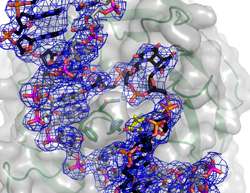Internal skin cancer prevention: Repairing UV damage in the skin

(Medical Xpress) -- Scientists at the Friedrich Miescher Institute for Biomedical Research (FMI) of the Novartis Research Foundation have elucidated the mechanisms underlying the repair of UV-induced damage in DNA, which frequently causes skin cancer. The protein structures additionally determined by these researchers will improve our understanding of how the body protects itself against skin cancer. These studies lay the foundations for the development of a new class of anti cancer agents. The findings were published today in Cell.
Without capturing public attention, the number of new cases of skin cancer is continuously increasing. This type of cancer is now more common than breast, colon and lung cancer combined. No less discouraging is the fact that the number of deaths from skin cancer is also steadily rising - in contrast to the trends observed for many other cancers, where survival rates are improving thanks to effective treatments. But reliable treatments can only be developed if the molecular mechanisms underlying skin cancer are better understood. Here, scientists at the FMI have made an important breakthrough, as they report in the latest issue of Cell.
It is well known that skin cancer arises from damage caused by the sun's ultraviolet (UV) radiation. This radiation produces mutations in DNA which influence cellular processes, possibly leading to cancer. Although the body has various strategies for repairing such damage, the most frequent type of UV lesion turns out to be particularly problematic. In this case, two components of DNA combine to form structures known as cyclobutane pyrimidine dimers (CPDs). These are difficult for the cell's repair system to detect - partly because they are inconspicuous, given the size of the entire genome, but also because they remain hidden within tightly coiled DNA.
Group Leader Nicolas Thomä and his team at the FMI, working together with colleagues from Kobe and Osaka, have now identified the molecular machinery which allows the cell to recognize lesions not detected by the normal repair system.
In these processes, a key role is played by a protein complex known as DDB1-DDB2-Cul4 ubiquitin ligase. A subunit of this complex, DDB2, specifically recognizes CPDs even if they are located in parts of the DNA which are tightly coiled. The researchers also showed how another protein in this complex, ubiquitin ligase, is activated by the binding of DDB2 to damaged DNA and thus directly triggers degradation processes in cells. Thomä comments: "With this work, for the first time, we've traced the steps whereby these common but treacherous genomic UV lesions are recognized and the cells are ultimately eliminated. The mechanism works like molecular sun cream, protecting cells from damage and thus preventing skin cancer."
But the findings are also relevant to diseases caused by defects in this repair mechanism, such as Cockayne syndrome or xeroderma pigmentosum. In both of these conditions, patients are extremely sensitive to UV radiation. However, they also exhibit other symptoms attributable to the accumulation of DNA errors. As Thomä explains, "The protein structures we've determined are a foundation on which specific inhibitors can be developed. Of particular interest here are the ubiquitin ligases, which not only play a role in rare diseases, but have been implicated in the development of many types of cancer."
More information: Fischer ES, Scrima A, Böhm K, Matsumoto S, Lingaraju GM, Faty M, Yasuda T, Cavadini S, Wakasugi M, Hanaoka F, Iwai S, Gut H, Sugasawa K, Thomä NH. (2011). "The molecular basis of CRL4(DDB2/CSA) ubiquitin ligase architecture, targeting and release of signalosome inhibition". Cell, 147, 5.
















